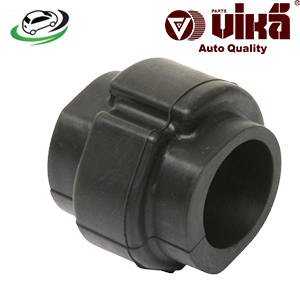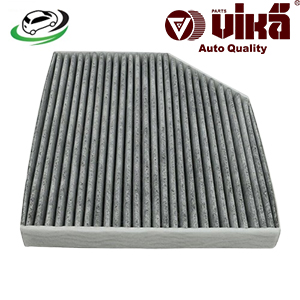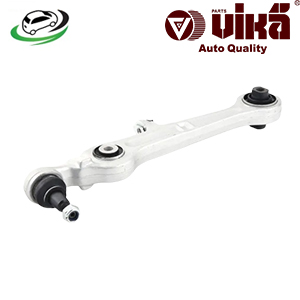-21%
Get Front Lower Track Control Arm AUDI A8/A4 Quattro/A6 / Volkswagen Passat 1997-2005 8E0407151M
The front lower track control arm, commonly referred to as the lower control arm, is a crucial component of a vehicle’s suspension system. It connects the front wheel hub to the frame of the car and plays a significant role in maintaining proper alignment, handling, and overall vehicle stability. In this comprehensive guide, we will explore the function, types, benefits, maintenance, and common issues associated with front lower track control arms.
Function of a Front Lower Track Control Arm
Connection to the Suspension System
The front lower track control arm connects the wheel hub to the vehicle’s chassis. It allows the wheel to move up and down while keeping it aligned with the frame, ensuring proper suspension geometry and stability.
Steering and Handling
The control arm helps to maintain the correct positioning of the wheels relative to the chassis, which is essential for accurate steering and handling. It supports the vehicle’s weight and absorbs road shocks and vibrations.
Alignment Maintenance
The control arm maintains the alignment of the wheels, ensuring that they stay in the correct position and angle relative to the road. This helps in providing a smooth and stable ride, minimizing tire wear and improving fuel efficiency.
Absorption of Road Impacts
The control arm absorbs and mitigates the impacts from road irregularities, such as bumps and potholes, contributing to a smoother and more comfortable ride.
Types of Front Lower Track Control Arms
- Stamped Steel Control Arms
- Construction: Made from stamped steel and typically coated to prevent rust.
- Advantages: Cost-effective, durable, and commonly used in many vehicles.
- Disadvantages: Can be heavy and may rust if the coating is damaged.
- Cast Iron Control Arms
- Construction: Made from cast iron, providing significant strength.
- Advantages: Very strong and durable.
- Disadvantages: Heavier than other types and can rust.
- Aluminum Control Arms
- Construction: Made from lightweight aluminum.
- Advantages: Lightweight, corrosion-resistant, and often used in performance vehicles.
- Disadvantages: More expensive and can be less durable under extreme conditions.
- Forged Control Arms
- Construction: Made through a forging process, resulting in high strength and durability.
- Advantages: Extremely strong and durable, often used in high-performance and off-road vehicles.
- Disadvantages: More expensive than other types.
Benefits of High-Quality Front Lower Track Control Arms
Improved Handling and Stability
High-quality control arms ensure that the wheels stay properly aligned and stable, resulting in better handling, cornering, and overall vehicle stability. This is especially important for maintaining control during high-speed driving or in emergency maneuvers.
Enhanced Ride Comfort
By effectively absorbing road impacts and vibrations, high-quality control arms contribute to a smoother and more comfortable ride, reducing fatigue for the driver and passengers.
Increased Durability and Longevity
Durable control arms are built to withstand the stresses and strains of driving, including rough roads and heavy loads. This reduces the frequency of replacements and lowers maintenance costs over the vehicle’s lifespan.
Reduced Tire Wear
Properly functioning control arms help maintain correct wheel alignment, which in turn minimizes uneven tire wear. This leads to longer tire life and better fuel efficiency.
Safety
Quality control arms play a critical role in maintaining the structural integrity of the suspension system, contributing to overall vehicle safety by ensuring stable and predictable handling.
Maintenance of Front Lower Track Control Arms
Regular Inspection
- Visual Checks: Regularly inspect the control arms for signs of wear, cracks, rust, or damage. Look for any bending or deformation of the control arm.
- Bushings and Ball Joints: Check the condition of the bushings and ball joints attached to the control arm. Worn or damaged bushings and ball joints can affect the performance of the control arm.
Lubrication
- Bushings and Joints: Some control arms, particularly those with polyurethane bushings, may require periodic lubrication to ensure smooth operation and prevent squeaking.
Alignment Checks
- Routine Alignment: Regularly check the wheel alignment to ensure that the control arms are functioning correctly and maintaining the proper geometry. Misalignment can lead to increased wear and reduced handling performance.
Replacement Intervals
- Manufacturer’s Recommendations: Follow the vehicle manufacturer’s guidelines for inspecting and replacing control arms. Control arms typically need to be replaced after a certain number of miles or years of use.
- Signs of Wear: Replace the control arms if you notice significant wear, cracks, or reduced handling performance. Do not wait for complete failure, as this can affect vehicle safety and handling.
Common Issues with Front Lower Track Control Arms
Wear and Tear
- Symptoms: Increased road noise, clunking sounds, and reduced handling performance.
- Causes: Over time, control arms can wear out due to constant stress, exposure to elements, and normal aging.
Cracks and Breakage
- Symptoms: Visible cracks in the control arm, misalignment of the wheels, and poor handling.
- Causes: Physical impact, such as hitting a pothole or curb, can cause cracks or breakage in the control arm.
Bushing and Ball Joint Wear
- Symptoms: Excessive play in the suspension, uneven tire wear, and clunking noises.
- Causes: Worn or damaged bushings and ball joints can affect the performance of the control arm, leading to handling issues and increased wear.
Corrosion
- Symptoms: Rust and corrosion on the control arm, leading to weakened structural integrity.
- Causes: Exposure to moisture, road salt, and other corrosive elements can cause rust and corrosion, particularly in steel and iron control arms.
Replacement of Front Lower Track Control Arms
Tools and Equipment
- Basic Tools: Wrenches, socket sets, screwdrivers, a jack, and jack stands.
- Replacement Control Arm: Ensure the new control arm is compatible with your vehicle’s make and model.
- Bushings and Ball Joints: New bushings and ball joints, if needed.
Steps for Replacement
- Safety First: Ensure the vehicle is securely supported on jack stands or a lift before starting the replacement process.
- Remove the Wheel: Remove the wheel to gain access to the control arm.
- Detach Components: Detach the control arm from the wheel hub and chassis. This typically involves removing bolts and possibly disconnecting the ball joint.
- Remove Old Control Arm: Carefully remove the old control arm from the vehicle.
- Install New Control Arm: Place the new control arm in position, ensuring it is properly aligned. Reattach the control arm to the wheel hub and chassis, securing it with the bolts.
- Reconnect Components: Reconnect any components that were detached, including the ball joint.
- Lower Vehicle: Once the new control arm is installed and secured, lower the vehicle back onto the ground.
- Test: Test drive the vehicle to check for any unusual noises or handling issues, ensuring the new control arm is functioning correctly.
Professional Assistance
If you are unfamiliar with vehicle maintenance or the replacement process, it is advisable to seek professional assistance to ensure proper installation and avoid potential issues.
Follow us on Facebook for more parts.



